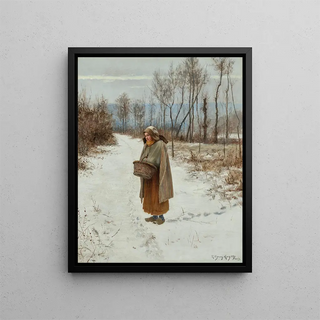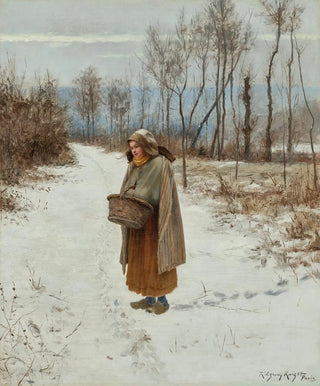Art print | She Lost Her Way - Daniel Ridgway Knight


View from behind

Frame (optional)
The artwork "She Has Lost Her Way" by Daniel Ridgway Knight is an invitation to contemplation, a painting that transports the viewer into a universe imbued with melancholy and beauty. Through the gaze of this young woman, lost in her thoughts, the artist manages to capture a universal emotion: that of inner quest. The scene, bathed in soft and warm light, evokes a moment suspended in time, where nature and humanity meet. This painting, rich in detail and color, serves as a true window into the soul, allowing each person to reflect on their own path.
Style and uniqueness of the artwork
Daniel Ridgway Knight's style is distinguished by its striking realism and meticulous attention to detail. In "She Has Lost Her Way," every element is carefully crafted, from the lush foliage surrounding the central figure to the delicate nuances of the sky. The artist's technique, which skillfully blends light and shadow, creates an intimate, almost tangible atmosphere. The posture of the young woman, slightly bent, suggests a touching vulnerability, while her lost gaze seems to question the world around her. This painting does not merely depict a scene; it tells a story, that of a soul seeking meaning, a path to discover. The color palette, soft and harmonious, reinforces this impression of serenity and reflection, making this piece a true masterpiece of Impressionist art.
The artist and his influence
Daniel Ridgway Knight, an emblematic figure of the 19th century, established himself on the artistic scene thanks to his unique approach to painting. Born in 1839 on the border between the United States and Europe, he was deeply influenced by the artistic movements of his time, notably realism and Impressionism. His journey led him to Paris, where he mingled with masters such as Monet and Renoir, but also drew inspiration from landscapes and scenes of everyday life. Knight has a particular talent for depicting women in all their complexity, oscillating between strength and fragility. "She Has Lost Her Way" perfectly illustrates this duality, making of

Matte finish

View from behind

Frame (optional)
The artwork "She Has Lost Her Way" by Daniel Ridgway Knight is an invitation to contemplation, a painting that transports the viewer into a universe imbued with melancholy and beauty. Through the gaze of this young woman, lost in her thoughts, the artist manages to capture a universal emotion: that of inner quest. The scene, bathed in soft and warm light, evokes a moment suspended in time, where nature and humanity meet. This painting, rich in detail and color, serves as a true window into the soul, allowing each person to reflect on their own path.
Style and uniqueness of the artwork
Daniel Ridgway Knight's style is distinguished by its striking realism and meticulous attention to detail. In "She Has Lost Her Way," every element is carefully crafted, from the lush foliage surrounding the central figure to the delicate nuances of the sky. The artist's technique, which skillfully blends light and shadow, creates an intimate, almost tangible atmosphere. The posture of the young woman, slightly bent, suggests a touching vulnerability, while her lost gaze seems to question the world around her. This painting does not merely depict a scene; it tells a story, that of a soul seeking meaning, a path to discover. The color palette, soft and harmonious, reinforces this impression of serenity and reflection, making this piece a true masterpiece of Impressionist art.
The artist and his influence
Daniel Ridgway Knight, an emblematic figure of the 19th century, established himself on the artistic scene thanks to his unique approach to painting. Born in 1839 on the border between the United States and Europe, he was deeply influenced by the artistic movements of his time, notably realism and Impressionism. His journey led him to Paris, where he mingled with masters such as Monet and Renoir, but also drew inspiration from landscapes and scenes of everyday life. Knight has a particular talent for depicting women in all their complexity, oscillating between strength and fragility. "She Has Lost Her Way" perfectly illustrates this duality, making of






